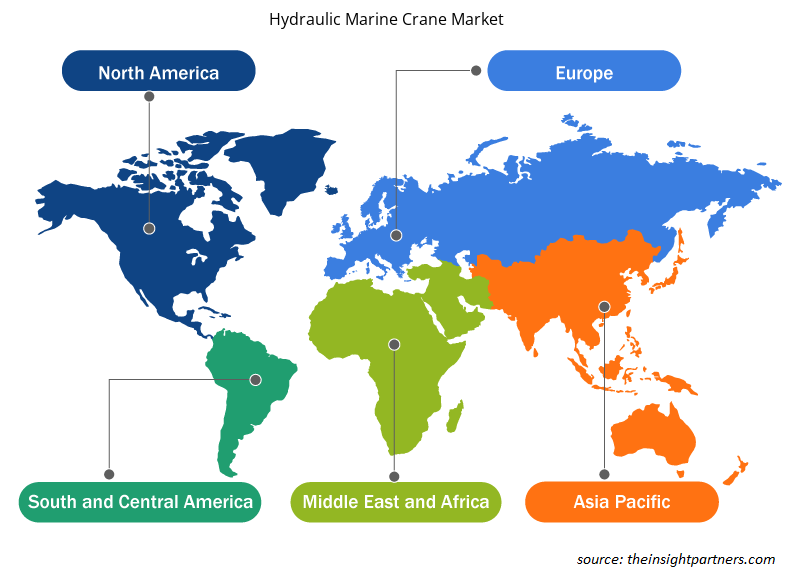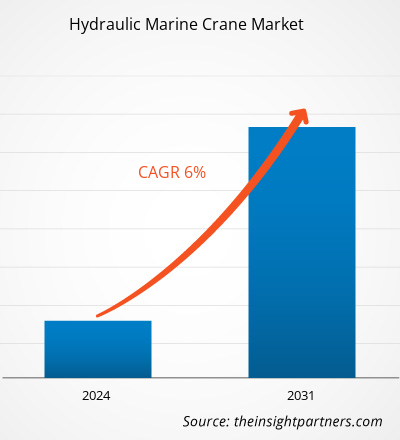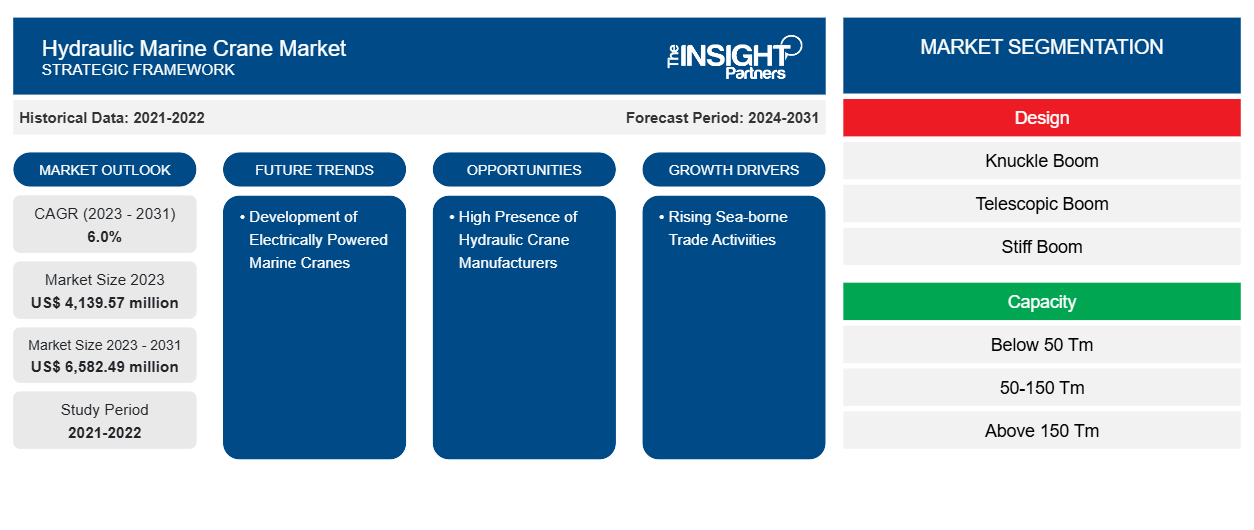Le marché des grues hydrauliques marines devrait atteindre 6 582,49 millions USD d'ici 2031, contre 4 139,57 millions USD en 2023. Le marché devrait enregistrer un TCAC de 6,0 % au cours de la période 2023-2031. Le nombre croissant d'activités commerciales maritimes et l'attention croissante du gouvernement portée au développement des infrastructures maritimes devraient rester une tendance clé du marché.
Analyse du marché des grues hydrauliques marines
Plusieurs investissements gouvernementaux dans la construction d'infrastructures maritimes ont augmenté la demande pour le marché des grues marines hydrauliques. Un grand nombre de fabricants de navires entraînerait directement une augmentation de la demande de grues marines hydrauliques à l'échelle mondiale. Les régions développées comme l'Amérique du Nord et l'Europe comptent des fabricants de grues marines de premier plan tels que DMW Marine Group et Fred Wahl Marine Construction, Inc., qui proposent des grues marines à flèche articulée, à flèche télescopique et à flèche rigide. Tous ces éléments augmenteront la croissance du marché des grues marines hydrauliques.
Aperçu du marché des grues hydrauliques marines
Les développements technologiques croissants permettent aux travailleurs de rester agiles. L'intégration de technologies de pointe dans les navires et plusieurs projets offshore stimulerait la croissance du marché des grues marines hydrauliques à l'échelle mondiale. Des pays comme l'Arabie saoudite achètent des flottes de transport maritime qui amélioreraient le déploiement de technologies de pointe dans plusieurs navires, tels que les cargos et les navires de guerre, entre autres. Pour mettre en œuvre et construire de nouvelles infrastructures technologiques, il faudrait des grues marines, ce qui oriente la demande de grues marines hydrauliques.
Personnalisez ce rapport en fonction de vos besoins
Vous bénéficierez d'une personnalisation gratuite de n'importe quel rapport, y compris de certaines parties de ce rapport, d'une analyse au niveau des pays, d'un pack de données Excel, ainsi que de superbes offres et réductions pour les start-ups et les universités.
-
Obtenez les principales tendances clés du marché de ce rapport.Cet échantillon GRATUIT comprendra une analyse de données, allant des tendances du marché aux estimations et prévisions.
Facteurs moteurs et opportunités du marché des grues hydrauliques marines
Le développement des activités commerciales maritimes favorise le marché
Les politiques et réglementations gouvernementales en faveur des activités commerciales internationales attirent les investissements étrangers. En outre, plusieurs gouvernements se concentrent sur le développement de l'industrie maritime et attirent les IDE dans ce secteur, ce qui accroît les activités commerciales maritimes et influence positivement le marché des grues hydrauliques. Les projets de développement technologique croissants construits dans les ports et dans les bâtiments navals influencent positivement les activités commerciales. Le nombre croissant d'activités commerciales maritimes nécessite des infrastructures portuaires et des installations de quai appropriées pour répondre au grand nombre de navires commerciaux, ce qui constitue un moteur majeur du marché mondial des grues hydrauliques.FDI in this sector, which is increasing the sea-borne trading activities and influencing the hydraulic crane market positively. The growing technological development projects constructed across ports and in ship buildings are positively influencing trading activities. The growing number of sea-bourne trading activities require proper port infrastructure and dock facilities to cater to the large number of commercial ships, which is acting as a major driver for the hydraulic machine crane market globally.
Forte présence de fabricants de grues hydrauliques
Le nombre de fabricants de grues marines dans des régions comme l'Europe, l'Asie-Pacifique et l'Amérique du Nord est élevé par rapport à d'autres régions. L'Italie, la Chine et les États-Unis figurent parmi les principaux pays comptant les plus grands fabricants de grues marines. Les types de grues marines disponibles dans ces régions sont les grues marines à flèche articulée, à flèche télescopique et à flèche rigide. Ainsi, avec un nombre plus élevé de fabricants de grues marines présents, le marché devrait connaître une croissance positive. Les États-Unis comptent également un grand nombre de fabricants de navires, ce qui entraînerait directement une augmentation de la demande de grues marines hydrauliques.
Analyse de segmentation du rapport sur le marché des grues hydrauliques marines
Les segments clés qui ont contribué à l’élaboration de l’analyse du marché des grues marines hydrauliques sont la conception, la capacité et la longueur de la flèche.
- En fonction de la conception, le marché des grues marines hydrauliques est divisé en flèche articulée, flèche télescopique , flèche rigide et flèche pliable. Le segment des flèches pliables détenait une part de marché plus importante en 2023.
- En termes de capacité, le marché est segmenté en moins de 50 Tm, 50-150 Tm et plus de 150 Tm. Le segment 50-150 Tm détenait une part importante du marché en 2023.
- En termes de longueur de flèche, le marché est segmenté en moins de 10 mètres, 10-20 mètres et plus de 20 mètres. Le segment inférieur à 10 mètres détenait une part importante du marché en 2023.
Analyse des parts de marché des grues hydrauliques marines par géographie
La portée géographique du rapport sur le marché des grues marines hydrauliques est principalement divisée en cinq régions : Amérique du Nord, Asie-Pacifique, Europe, Moyen-Orient et Afrique, et Amérique du Sud et centrale.
L'Europe est leader du marché. Les investissements gouvernementaux importants dans le développement des infrastructures maritimes ont eu une influence positive sur la demande du marché des grues marines hydrauliques dans la région. Les projets de développement technologique croissants dans les ports et dans la fabrication de navires augmentent la demande de grues marines hydrauliques sur les marchés européens. L'Europe est une région économiquement avancée. Le Royaume-Uni, l'Espagne, l'Italie, la France, l'Allemagne, la Suisse, la Russie, la Suède et les Pays-Bas sont quelques-uns des principaux pays de la région. La forte présence des fabricants de construction navale et de grues hydrauliques a également un impact positif sur le marché des grues marines hydrauliques en Europe.
Aperçu régional du marché des grues hydrauliques marines
Les tendances régionales et les facteurs influençant le marché des grues marines hydrauliques tout au long de la période de prévision ont été expliqués en détail par les analystes d’Insight Partners. Cette section traite également des segments et de la géographie du marché des grues marines hydrauliques en Amérique du Nord, en Europe, en Asie-Pacifique, au Moyen-Orient et en Afrique, ainsi qu’en Amérique du Sud et en Amérique centrale.

- Obtenez les données régionales spécifiques au marché des grues marines hydrauliques
Portée du rapport sur le marché des grues hydrauliques marines
| Attribut de rapport | Détails |
|---|---|
| Taille du marché en 2023 | 4 139,57 millions USD |
| Taille du marché d'ici 2031 | 6 582,49 millions de dollars américains |
| Taux de croissance annuel composé mondial (2023-2031) | 6,0% |
| Données historiques | 2021-2022 |
| Période de prévision | 2024-2031 |
| Segments couverts |
Par conception
|
| Régions et pays couverts |
Amérique du Nord
|
| Leaders du marché et profils d'entreprises clés |
|
Densité des acteurs du marché : comprendre son impact sur la dynamique des entreprises
Le marché des grues marines hydrauliques connaît une croissance rapide, tirée par la demande croissante des utilisateurs finaux en raison de facteurs tels que l'évolution des préférences des consommateurs, les avancées technologiques et une plus grande sensibilisation aux avantages du produit. À mesure que la demande augmente, les entreprises élargissent leurs offres, innovent pour répondre aux besoins des consommateurs et capitalisent sur les tendances émergentes, ce qui alimente davantage la croissance du marché.
La densité des acteurs du marché fait référence à la répartition des entreprises ou des sociétés opérant sur un marché ou un secteur particulier. Elle indique le nombre de concurrents (acteurs du marché) présents sur un marché donné par rapport à sa taille ou à sa valeur marchande totale.
Les principales entreprises opérant sur le marché des grues marines hydrauliques sont :
- Amco Veba Marine
- Groupe DMW Marine
- Fassi Gru SpA
- Fred Wahl Marine Construction, Inc.
- Heila Cranes SpA
- Hydrauliska Industrie AB
Avis de non-responsabilité : les sociétés répertoriées ci-dessus ne sont pas classées dans un ordre particulier.

- Obtenez un aperçu des principaux acteurs du marché des grues marines hydrauliques
Actualités et développements récents du marché des grues hydrauliques marines
Le marché des grues marines hydrauliques est évalué en collectant des données qualitatives et quantitatives après des recherches primaires et secondaires, qui comprennent des publications d'entreprise importantes, des données d'association et des bases de données. Quelques-uns des développements sur le marché des grues marines hydrauliques sont énumérés ci-dessous :
- Amco Veba Marine a lancé 40tm de grues marines. (Source : Amco Veba Marine, Communiqué de presse, mai 2022)
- Les grues des catégories V820NM et V823NM d'Amco Veba Marine ont été certifiées conformes à la norme DNV-ST-0377 relative aux appareils de levage à bord des navires par DNV. (Source : Amco Veba Marine, communiqué de presse, septembre 2022)
Rapport sur le marché des grues hydrauliques marines : couverture et livrables
Le rapport « Taille et prévisions du marché des grues marines hydrauliques (2021-2031) » fournit une analyse détaillée du marché couvrant les domaines ci-dessous :
- Taille et prévisions du marché des grues hydrauliques marines aux niveaux mondial, régional et national pour tous les segments de marché clés couverts par le périmètre
- Tendances du marché des grues hydrauliques marines ainsi que la dynamique du marché telles que les facteurs déterminants, les contraintes et les opportunités clés
- Analyse PEST et SWOT détaillée
- Analyse du marché des grues marines hydrauliques couvrant les principales tendances du marché, le cadre mondial et régional, les principaux acteurs, les réglementations et les développements récents du marché
- Analyse du paysage industriel et de la concurrence couvrant la concentration du marché, l'analyse de la carte thermique, les principaux acteurs et les développements récents pour le marché des grues marines hydrauliques
- Profils d'entreprise détaillés
- Analyse historique (2 ans), année de base, prévision (7 ans) avec TCAC
- Analyse PEST et SWOT
- Taille du marché Valeur / Volume - Mondial, Régional, Pays
- Industrie et paysage concurrentiel
- Ensemble de données Excel
Rapports récents
Rapports connexes
Témoignages
Raison d'acheter
- Prise de décision éclairée
- Compréhension de la dynamique du marché
- Analyse concurrentielle
- Connaissances clients
- Prévisions de marché
- Atténuation des risques
- Planification stratégique
- Justification des investissements
- Identification des marchés émergents
- Amélioration des stratégies marketing
- Amélioration de l'efficacité opérationnelle
- Alignement sur les tendances réglementaires























 Obtenez un échantillon gratuit pour - Marché des grues hydrauliques marines
Obtenez un échantillon gratuit pour - Marché des grues hydrauliques marines